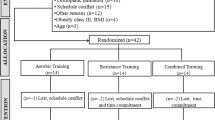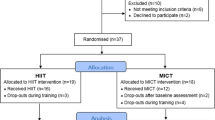Abstract
Muscle contractions in normal resistance training are performed by eccentric (ECC, lowering phase) and concentric (CON, lifting phase) muscle contractions. However, the difference in effects of timing of muscle contraction during resistance training on arterial stiffness is unknown. This study investigated the effect of muscle contraction timing during resistance training on vascular function in healthy young adults. Thirty healthy men were randomly assigned to group of resistance training with quick lifting and slow lowering (ERT, n=10), group of resistance training with slow lifting and quick lowering (CRT, n=10) and sedentary groups (SED, n=10). The ERT and CRT groups underwent two supervised resistance-training sessions per week for 10 weeks. The ERT group performed the on set of 8–10 repetitions with 3 s ECC and 1 s CON muscle contractions. In contrast, the CRT group performed the on set of 8–10 repetitions with 1 s ECC and 3 s CON muscle contractions. Brachial–ankle pulse wave velocity (baPWV) after ERT did not change from baseline. In contrast, baPWV after CRT increased from baseline (from 1049±37 to 1153±30 cm s−1, P<0.05). No significant changes in flow-mediated dilation were observed in the ERT and CRT groups. These values did not change in the SED group. These findings suggest that although both training does not deteriorate a vascular endothelial function, resistance training with quick lifting and slow lowering (that is, ERT) prevent the stiffening of arterial stiffness.
This is a preview of subscription content, access via your institution
Access options
Subscribe to this journal
Receive 12 digital issues and online access to articles
$119.00 per year
only $9.92 per issue
Buy this article
- Purchase on Springer Link
- Instant access to full article PDF
Prices may be subject to local taxes which are calculated during checkout


Similar content being viewed by others
References
Tanaka H, Dinenno FA, Hunt BE, Jones PP, DeSouza CA, Seals DR . Hemodynamic sequelae of age-related increases in arterial stiffness in healthy women. Am J Cardiol 1998; 82: 1152–1155.
Safar ME, London GM . The Clinical Committee of Arterial Structure and Function, Working Group on Vascular Structure and Function of the European Society of Hypertension: Therapeutic studies and arterial stiffness in hypertension: recommendations of the European Society of Hypertension. J Hypertens 2000; 18: 1527–1535.
Monahan KD, Tanaka H, Dinenno FA, Seals DR . Central arterial compliance is associated with age- and habitual exercise-related differences in cardiovagal baroreflex sensitivity. Circulation 2001; 104: 1627–1632.
Laurent S, Boutouyrie P, Asmar R, Gautier I, Laloux B, Guize L et al. Aortic stiffness is an independent predictor of all-cause and cardiovascular mortality in hypertensive patients. Hypertension 2001; 37: 1236–1241.
Cruickshank K, Riste L, Anderson SG, Wright JS, Dunn G, Gosling RG . Aortic pulse wave velocity and its relationship to mortality in diabetes and glucose intolerance: an integrated index of vascular function? Circulation 2002; 106: 2085–2090.
Blacher J, London GM, Safar B, Mourad JJ . Influence of age and end-stage renal disease on the stiffness of carotid wall material in hypertension. J Hypertens 1999; 17: 237–244.
Pollock ML, Franklin BA, Balady GJ, Chaitman BL, Fleg JL, Fletcher B et al. AHA Science Advisory. Resistance exercise in individuals with and without cardiovascular disease: benefits, rationale, safety, and prescription: an advisory from the Committee on Exercise, Rehabilitation, and Prevention, Council on Clinical Cardiology, American Heart Association; Position paper endorsed by the American College of Sports Medicine. Circulation 2000; 101: 828–833.
Stewart KJ, Bacher AC, Turner K, Lim JG, Hees PS, Shapiro EP et al. Exercise and risk factors associated with metabolic syndrome in older adults. Am J Prev Med 2005; 28: 9–18.
Eves ND, Plotnikoff RC . Resistance training and type 2 diabetes: considerations for implementation at the population level. Diabetes Care 2006; 29: 1933–1941.
Miyachi M, Kawano H, Sugawara J, Takahashi K, Hayashi K, Yamazaki K et al. Unfavorable effects of resistance training on central arterial compliance: a randomized intervention study. Circulation 2004; 110: 2858–2863.
Cortez-Cooper MY, DeVan AE, Anton MM, Farrar RP, Beckwith KA, Todd JS et al. Effects of high intensity resistance training on arterial stiffness and wave reflection in women. Am J Hypertens 2005; 18: 930–934.
Okamoto T, Masuhara M, Ikuta K . Effects of eccentric and concentric resistance training on arterial stiffness. J Hum Hypertens 2006; 20: 348–354.
Okamoto T, Masuhara M, Ikuta K . Relationship between plasma endothelin-1 concentration and cardiovascular responses during high-intensity eccentric and concentric exercise. Clin Physiol Funct Imaging 2008; 28: 43–48.
Otsuki T, Maeda S, Iemitsu M, Saito Y, Tanimura Y, Ajisaka R et al. Effects of athletic strength and endurance exercise training in young humans on plasma endothelin-1 concentration and arterial distensibility. Exp Biol Med 2006; 231: 789–793.
Sugawara J, Hayashi K, Yokoi T, Cortez-Cooper MY, DeVan AE, Anton MA et al. Brachial-ankle pulse wave velocity: an index of central arterial stiffness? J Hum Hypertens 2005; 19: 401–406.
Corretti MC, Anderson TJ, Benjamin EJ, Celermajer D, Charbonneau F, Creager MA et al. Guidelines for qthe ultrasound assessment of endothelial-dependent flow-mediated vasodilation of the brachial artery: a report of the International Brachial Artery Reactivity Task Force. J Am Coll Cardiol 2002; 39: 257–265.
Johnson BL . Eccentric and concentric muscle training for strength development. Med Sci Sports Exerc 1972; 4: 111–115.
Hortobágyi T, Barrier J, Beard D, Braspennincx J, Koens P, Devita P et al. Greater initial adaptations to the submaximal lengthening than maximal shortening. J Appl Physiol 1996; 81: 1677–1682.
Hortobagyi T, Hill JP, Houmard JA, Fraser DD, Lambert NJ, Israel RG . Adaptive responses to muscle lengthening and shortening in humans. J Appl Physiol 1996; 80: 765–772.
Asmar R, Benetos A, Topouchian J, Laurent P, Pannier B, Brisac AM et al. Assessment of arterial distensibility by automatic pulse wave velocity measurement. Validation and clinical application studies. Hypertension 1995; 26: 485–490.
Lehmann ED . Clinical value of aortic pulse-wave velocity measurement. Lancet 1999; 354: 528–529.
Munakata M, Nunokawa T, Yoshinaga K, Toyota T, J-TOPP Study Group. Brachial-ankle pulse wave velocity is an independent risk factor for microalbuminuria in patients with essential hypertension—a Japanese trial on the prognostic implication of pulse wave velocity (J-TOPP). Hypertens Res 2006; 29: 515–521.
Mimura T, Takenaka T, Kanno Y, Moriwaki K, Okada H, Suzuki H . Vascular compliance is secured under angiotensin inhibition in non-diabetic chronic kidney diseases. J Hum Hypertens 2008; 22: 38–47.
Okamoto T, Masuhara M, Ikuta K . Combined aerobic and resistance training and vascular function: effect of aerobic exercise before and after resistance training. J Appl Physiol 2007; 103: 1655–1661.
Dobrin PB . Mechanical factors associated with the development of intimal and medial thickening in vein grafts subjected to arterial pressure: a model of arteries exposed to hypertension. Hypertension 1995; 26: 38–43.
MacDougall JD, Tuxen D, Sale DG, Moroz JR, Sutton JR . Arterial blood pressure response to heavy resistance exercise. J Appl Physiol 1985; 58: 785–790.
Pratley R, Nicklas B, Rubin M, Miller J, Smith A, Smith M et al. Strength training increases resting metabolic rate and norepinephrine levels in healthy 50- to 65-yr-old men. J Appl Physiol 1994; 76: 133–137.
Raastad T, Glomsheller T, Bjoro T, Hallen J . Changes in human skeletal muscle contractility and hormone status during 2 weeks of heavy strength training. Eur J Appl Physiol 2001; 84: 54–63.
Carrasco DI, Delp MD, Ray CA . Effect of concentric and eccentric muscle actions on muscle sympathetic nerve activity. J Appl Physiol 1999; 86: 558–563.
Moncada S, Higgs EA . Endogenous nitric oxide: physiology, pathology and clinical relevance. Eur J Clin Invest 1991; 21: 361–374.
Rakobowchuk M, McGowan CL, de Groot PC, Hartman JW, Phillips SM, MacDonald MJ . Endothelial function of young healthy males following whole body resistance training. J Appl Physiol 2005; 98: 2185–2190.
Kawano H, Tanimoto M, Yamamoto K, Sanada K, Gando Y, Tabata I et al. Resistance training in men is associated with increased arterial stiffness and blood pressure but does not adversely affect endothelial function as measured by arterial reactivity to the cold pressor test. Exp Physiol 2008; 93: 296–302.
Jurva JW, Phillips SA, Syed AQ, Syed AY, Pitt S, Weaver A et al. The effect of exertional hypertension evoked by weight lifting on vascular endothelial function. J Am Coll Cardiol 2006; 48: 588–589.
Miyachi M, Tanaka H, Kawano H, Okajima M, Tabata I . Lack of age-related decreases in basal whole leg blood flow in resistance-trained men. J Appl Physiol 2005; 99: 1384–1390.
Anton MM, Cortez-Cooper MY, DeVan AE, Neidre DB, Cook JN, Tanaka H . Resistance training increases basal limb blood flow and vascular conductance in aging humans. J Appl Physiol 2006; 101: 1351–1355.
Dinenno FA, Tanaka H, Monahan KD, Clevenger CM, Eskurza I, DeSouza CA et al. Regular endurance exercise induces expansive arterial remodeling in the trained limbs of healthy men. J Physiol 2001; 534: 287–295.
Acknowledgements
This research was partially supported by the Ministry of Education, Science, Sports and Culture, Grant-in-Aid for Young Scientists (B), 19700539, 2007.
Author information
Authors and Affiliations
Corresponding author
Rights and permissions
About this article
Cite this article
Okamoto, T., Masuhara, M. & Ikuta, K. Effects of muscle contraction timing during resistance training on vascular function. J Hum Hypertens 23, 470–478 (2009). https://doi.org/10.1038/jhh.2008.152
Received:
Revised:
Accepted:
Published:
Issue Date:
DOI: https://doi.org/10.1038/jhh.2008.152
Keywords
This article is cited by
-
Is individual day-to-day variation of arterial stiffness associated with variation of maximal aerobic performance?
BMC Sports Science, Medicine and Rehabilitation (2021)
-
Impact of high- and low-intensity resistance training on arterial stiffness and blood pressure in adults across the lifespan: a review
Pflügers Archiv - European Journal of Physiology (2019)
-
Exercise Modalities and Endothelial Function: A Systematic Review and Dose–Response Meta-Analysis of Randomized Controlled Trials
Sports Medicine (2015)
-
Arterial compliance and stiffness following low-intensity resistance exercise
European Journal of Applied Physiology (2014)
-
Effects of high-intensity and blood flow-restricted low-intensity resistance training on carotid arterial compliance: role of blood pressure during training sessions
European Journal of Applied Physiology (2013)



